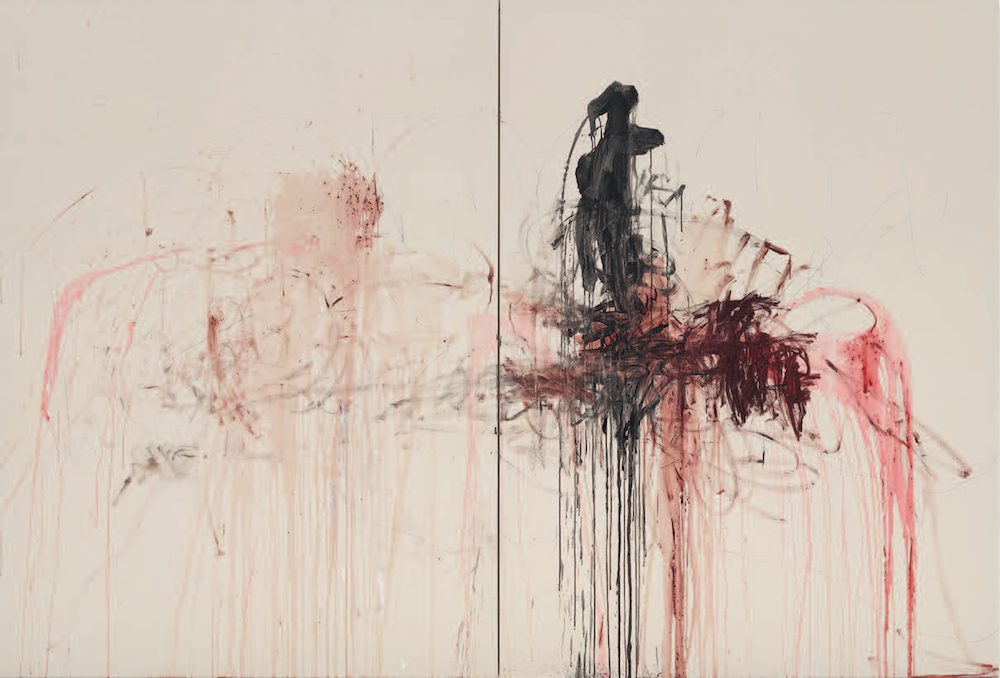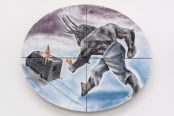Jonathan Jones’ concise Tracey Emin biography reads at times like a Romantics swirling, poetic tableau. A seismic paradox when one considers Emin herself, an artist whose name is synonymous with shock and outrage. Jones’ book eviscerates the image of the vodka-swigging vision that delighted in courting controversy in the 90s, replacing it with a fondness for ouija boards, abjection and what Jones refers to as ‘the socialism of the lonely’.
Tracing the path of her work to the south of France and her mountain hideout, Jones finds Emin has reinvented herself as something of a spiritualist medium, channelling the echoes and ghosts of those that still haunt her. She conjures images of Mary Shelley’s séances on the shores of Lake Geneva, as she paints in ecstatic reverie, her canvas the thunder rolling around the hills, her paintbrush the flashes of lightning that illuminate the studio.
Emin’s career began in 1977. Compelled by David Bowie’s Heroes, the young artist sought out Egon Schiele, the inspiration for the album’s iconic photographic artwork. Schiele’s influence manifested in an early passion for expressionism, a shift in vision from the empirical world to the experience of the ‘soul’ and her hometown of Margate becoming her Elysian Fields.

The 90s saw millennial anxiety and fin-de-siècle nihilism convert the gallery spaces of London into an apocalyptic nightmare world. Here we saw a transition in Emin’s work from woodcuts and engravings, to the personal readymades she exhibited with other artists at the Royal Academy of Art in 1997. The Sensation: Young British Artists from the Saatchi Collection exhibition was a milestone in 20th century British art and made many of the artists involved household names, including Emin, who embarked on a love-hate relationship with the British press. Her piece, My Bed (1998), was devoid of the obligatory, reclining nude; instead, the soiled sheets were scattered with used condoms, fag ends and empty vodka bottles. It scandalised 90s sensibilities and challenged the contemporary view of art more so than any of her peers. Lost in the whirlwind of publicity was the tenderness of Emin’s hand-stitched and embroidered other works; not just ‘readymades’ in the Duchamp, Warhol sense, these were intensely personal forays into a safe space for Emin to explore and express her truth. Years later, after the fires that destroyed Saatchi’s collection, Emin was asked to recreate ‘Everyone I Have Ever Slept With 1963–1995 (1995), a piece which had burned in the flames. She flatly refused.

The 21st century has seen Emin move away from the readymade aesthetic of her early years and into a shamanic, visceral realm of paintings of the female form. These works are freed from the projections of the objectifying lens of the male gaze, for it is Emin herself who is the model and her own body the arena of discovery. Reclaiming her own flesh is no more provocative than in Rape (2018), a shocking abstract amalgam of arms, legs, bodily excretions and blood, lots of blood, or the photographic piece, The Memory of Your Touch (2016), in which an unconscious Emin lies face down on a bed, red stockings and bra straps her only covering. There’s no air brush, no filters, just raw, savage realness.
Emin continues to have the power to shock, to share her personal experience in a way that is confrontational and uncomfortable. Yet, as Jones’ book shows, she remains one of the most important, engaging and unique voices in today’s contemporary art world.
Tracey Emin by Jonathan Jones is published by Laurence King and available now.
Image: Emin in her studio in the South of France, 2017 © Tracey Emin. All rights reserved, DACS:Artimage 2020
I write short stories and poetry alongside studying religion and anthropology at the University of Manchester. My story “Girl’s World” was in the highly recommended list for the Manchester Fiction prize 2019.



















